Hairong Wang
A Holistic Weakly Supervised Approach for Liver Tumor Segmentation with Clinical Knowledge-Informed Label Smoothing
Oct 13, 2024



Abstract:Liver cancer is a leading cause of mortality worldwide, and accurate CT-based tumor segmentation is essential for diagnosis and treatment. Manual delineation is time-intensive, prone to variability, and highlights the need for reliable automation. While deep learning has shown promise for automated liver segmentation, precise liver tumor segmentation remains challenging due to the heterogeneous nature of tumors, imprecise tumor margins, and limited labeled data. We present a novel holistic weakly supervised framework that integrates clinical knowledge to address these challenges with (1) A knowledge-informed label smoothing technique that leverages clinical data to generate smooth labels, which regularizes model training reducing the risk of overfitting and enhancing model performance; (2) A global and local-view segmentation framework, breaking down the task into two simpler sub-tasks, allowing optimized preprocessing and training for each; and (3) Pre- and post-processing pipelines customized to the challenges of each subtask, which enhances tumor visibility and refines tumor boundaries. We evaluated the proposed method on the HCC-TACE-Seg dataset and showed that these three key components complementarily contribute to the improved performance. Lastly, we prototyped a tool for automated liver tumor segmentation and diagnosis summary generation called MedAssistLiver. The app and code are published at https://github.com/lingchm/medassist-liver-cancer.
Knowledge-Informed Machine Learning for Cancer Diagnosis and Prognosis: A review
Jan 12, 2024Abstract:Cancer remains one of the most challenging diseases to treat in the medical field. Machine learning has enabled in-depth analysis of rich multi-omics profiles and medical imaging for cancer diagnosis and prognosis. Despite these advancements, machine learning models face challenges stemming from limited labeled sample sizes, the intricate interplay of high-dimensionality data types, the inherent heterogeneity observed among patients and within tumors, and concerns about interpretability and consistency with existing biomedical knowledge. One approach to surmount these challenges is to integrate biomedical knowledge into data-driven models, which has proven potential to improve the accuracy, robustness, and interpretability of model results. Here, we review the state-of-the-art machine learning studies that adopted the fusion of biomedical knowledge and data, termed knowledge-informed machine learning, for cancer diagnosis and prognosis. Emphasizing the properties inherent in four primary data types including clinical, imaging, molecular, and treatment data, we highlight modeling considerations relevant to these contexts. We provide an overview of diverse forms of knowledge representation and current strategies of knowledge integration into machine learning pipelines with concrete examples. We conclude the review article by discussing future directions to advance cancer research through knowledge-informed machine learning.
Quantifying intra-tumoral genetic heterogeneity of glioblastoma toward precision medicine using MRI and a data-inclusive machine learning algorithm
Dec 30, 2023Abstract:Glioblastoma (GBM) is one of the most aggressive and lethal human cancers. Intra-tumoral genetic heterogeneity poses a significant challenge for treatment. Biopsy is invasive, which motivates the development of non-invasive, MRI-based machine learning (ML) models to quantify intra-tumoral genetic heterogeneity for each patient. This capability holds great promise for enabling better therapeutic selection to improve patient outcomes. We proposed a novel Weakly Supervised Ordinal Support Vector Machine (WSO-SVM) to predict regional genetic alteration status within each GBM tumor using MRI. WSO-SVM was applied to a unique dataset of 318 image-localized biopsies with spatially matched multiparametric MRI from 74 GBM patients. The model was trained to predict the regional genetic alteration of three GBM driver genes (EGFR, PDGFRA, and PTEN) based on features extracted from the corresponding region of five MRI contrast images. For comparison, a variety of existing ML algorithms were also applied. The classification accuracy of each gene was compared between the different algorithms. The SHapley Additive exPlanations (SHAP) method was further applied to compute contribution scores of different contrast images. Finally, the trained WSO-SVM was used to generate prediction maps within the tumoral area of each patient to help visualize the intra-tumoral genetic heterogeneity. This study demonstrated the feasibility of using MRI and WSO-SVM to enable non-invasive prediction of intra-tumoral regional genetic alteration for each GBM patient, which can inform future adaptive therapies for individualized oncology.
A Novel Hybrid Ordinal Learning Model with Health Care Application
Dec 15, 2023
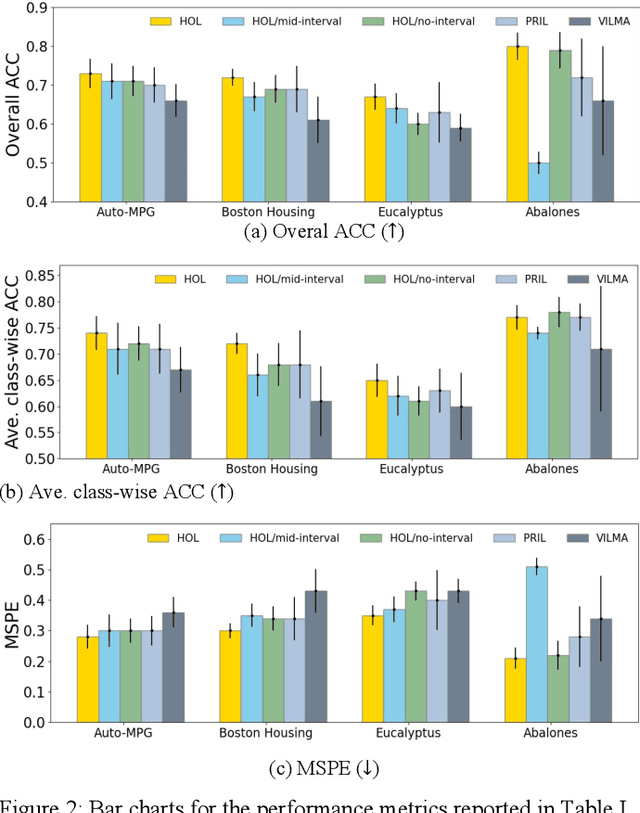

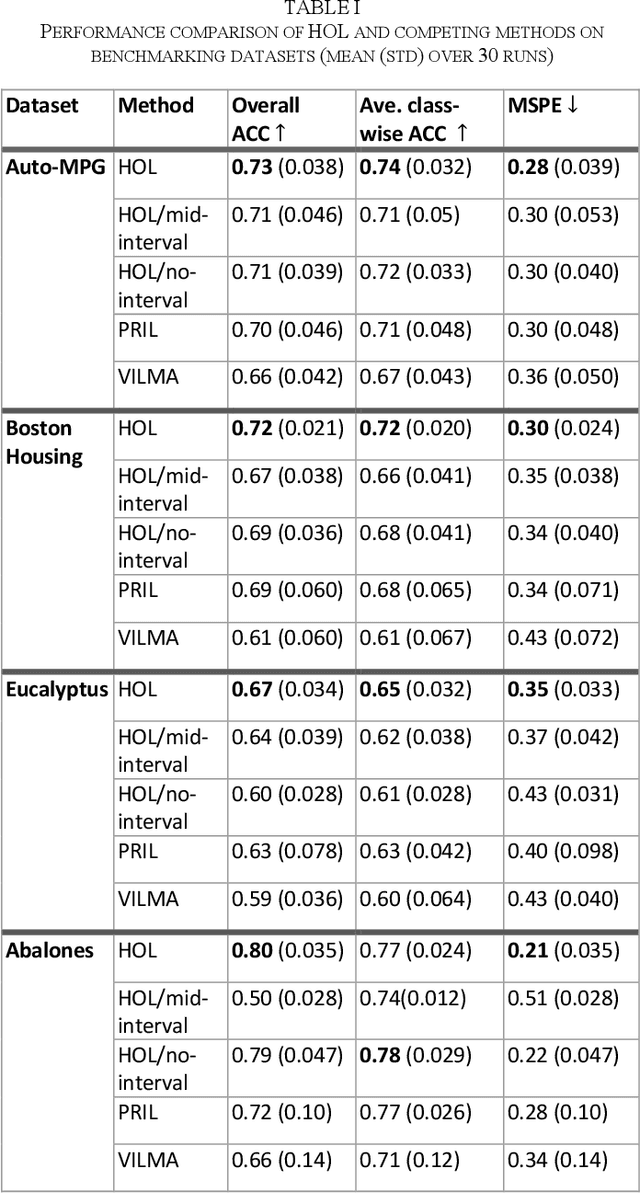
Abstract:Ordinal learning (OL) is a type of machine learning models with broad utility in health care applications such as diagnosis of different grades of a disease (e.g., mild, modest, severe) and prediction of the speed of disease progression (e.g., very fast, fast, moderate, slow). This paper aims to tackle a situation when precisely labeled samples are limited in the training set due to cost or availability constraints, whereas there could be an abundance of samples with imprecise labels. We focus on imprecise labels that are intervals, i.e., one can know that a sample belongs to an interval of labels but cannot know which unique label it has. This situation is quite common in health care datasets due to limitations of the diagnostic instrument, sparse clinical visits, or/and patient dropout. Limited research has been done to develop OL models with imprecise/interval labels. We propose a new Hybrid Ordinal Learner (HOL) to integrate samples with both precise and interval labels to train a robust OL model. We also develop a tractable and efficient optimization algorithm to solve the HOL formulation. We compare HOL with several recently developed OL methods on four benchmarking datasets, which demonstrate the superior performance of HOL. Finally, we apply HOL to a real-world dataset for predicting the speed of progressing to Alzheimer's Disease (AD) for individuals with Mild Cognitive Impairment (MCI) based on a combination of multi-modality neuroimaging and demographic/clinical datasets. HOL achieves high accuracy in the prediction and outperforms existing methods. The capability of accurately predicting the speed of progression to AD for each individual with MCI has the potential for helping facilitate more individually-optimized interventional strategies.
Translated Skip Connections -- Expanding the Receptive Fields of Fully Convolutional Neural Networks
Nov 03, 2022Abstract:The effective receptive field of a fully convolutional neural network is an important consideration when designing an architecture, as it defines the portion of the input visible to each convolutional kernel. We propose a neural network module, extending traditional skip connections, called the translated skip connection. Translated skip connections geometrically increase the receptive field of an architecture with negligible impact on both the size of the parameter space and computational complexity. By embedding translated skip connections into a benchmark architecture, we demonstrate that our module matches or outperforms four other approaches to expanding the effective receptive fields of fully convolutional neural networks. We confirm this result across five contemporary image segmentation datasets from disparate domains, including the detection of COVID-19 infection, segmentation of aerial imagery, common object segmentation, and segmentation for self-driving cars.
* 5 pages, 2 figures, 1 table, published at the 2022 IEEE International Conference on Image Processing
Multi-Modal Recommendation System with Auxiliary Information
Oct 13, 2022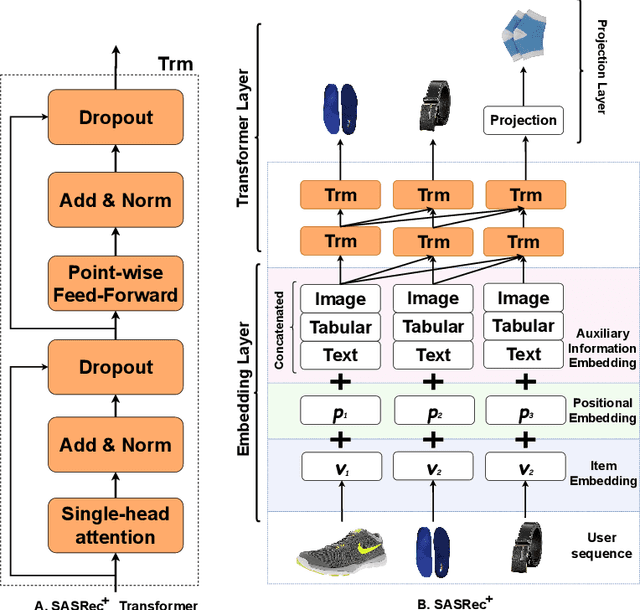
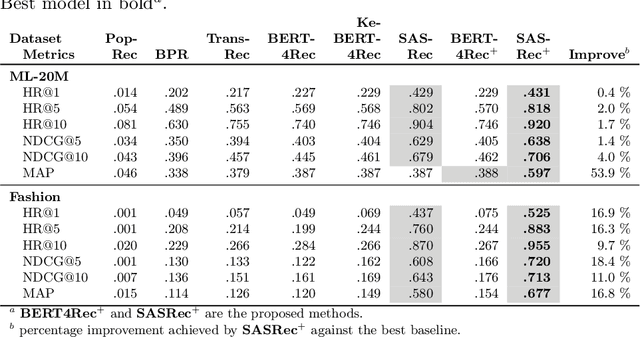
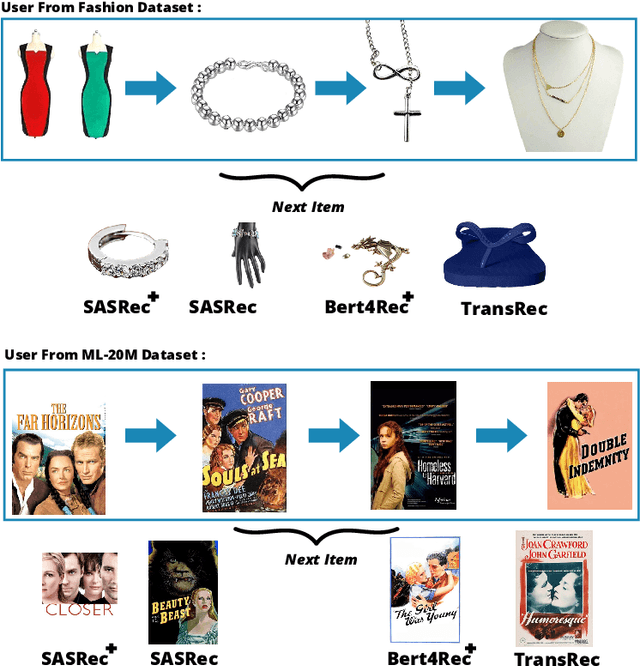
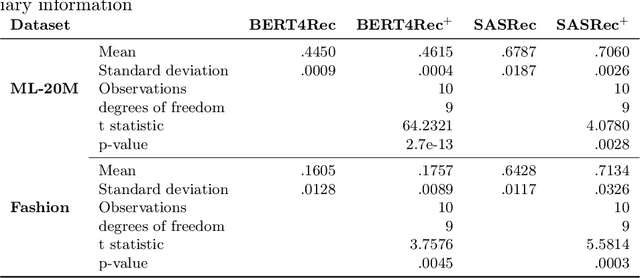
Abstract:Context-aware recommendation systems improve upon classical recommender systems by including, in the modelling, a user's behaviour. Research into context-aware recommendation systems has previously only considered the sequential ordering of items as contextual information. However, there is a wealth of unexploited additional multi-modal information available in auxiliary knowledge related to items. This study extends the existing research by evaluating a multi-modal recommendation system that exploits the inclusion of comprehensive auxiliary knowledge related to an item. The empirical results explore extracting vector representations (embeddings) from unstructured and structured data using data2vec. The fused embeddings are then used to train several state-of-the-art transformer architectures for sequential user-item representations. The analysis of the experimental results shows a statistically significant improvement in prediction accuracy, which confirms the effectiveness of including auxiliary information in a context-aware recommendation system. We report a 4% and 11% increase in the NDCG score for long and short user sequence datasets, respectively.
Dictionary learning for clustering on hyperspectral images
Feb 02, 2022Abstract:Dictionary learning and sparse coding have been widely studied as mechanisms for unsupervised feature learning. Unsupervised learning could bring enormous benefit to the processing of hyperspectral images and to other remote sensing data analysis because labelled data are often scarce in this field. We propose a method for clustering the pixels of hyperspectral images using sparse coefficients computed from a representative dictionary as features. We show empirically that the proposed method works more effectively than clustering on the original pixels. We also demonstrate that our approach, in certain circumstances, outperforms the clustering results of features extracted using principal component analysis and non-negative matrix factorisation. Furthermore, our method is suitable for applications in repetitively clustering an ever-growing amount of high-dimensional data, which is the case when working with hyperspectral satellite imagery.
* Springer Machine Learning Journal, 8 pages, 3 figures
Improved Image Coding Autoencoder With Deep Learning
Feb 28, 2020



Abstract:In this paper, we build autoencoder based pipelines for extreme end-to-end image compression based on Ball\'e's approach, which is the state-of-the-art open source implementation in image compression using deep learning. We deepened the network by adding one more hidden layer before each strided convolutional layer with exactly the same number of down-samplings and up-samplings. Our approach outperformed Ball\'e's approach, and achieved around 4.0% reduction in bits per pixel (bpp), 0.03% increase in multi-scale structural similarity (MS-SSIM), and only 0.47% decrease in peak signal-to-noise ratio (PSNR), It also outperforms all traditional image compression methods including JPEG2000 and HEIC by at least 20% in terms of compression efficiency at similar reconstruction image quality. Regarding encoding and decoding time, our approach takes similar amount of time compared with traditional methods with the support of GPU, which means it's almost ready for industrial applications.
 Add to Chrome
Add to Chrome Add to Firefox
Add to Firefox Add to Edge
Add to Edge